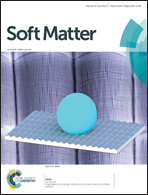Polyelectrolyte scaling laws for microgel yielding near jamming
Abstract
Micro-scale hydrogel particles, known as microgels, are used in industry to control the rheology of numerous different products, and are also used in experimental research to study the origins of jamming and glassy behavior in soft-sphere model systems. At the macro-scale, the rheological behaviour of densely packed microgels has been thoroughly characterized; at the particle-scale, careful investigations of jamming, yielding, and glassy-dynamics have been performed through experiment, theory, and simulation. However, at low packing fractions near jamming, the connection between microgel yielding phenomena and the physics of their constituent polymer chains has not been made. Here we investigate whether basic polymer physics scaling laws predict macroscopic yielding behaviours in packed microgels. We measure the yield stress and cross-over shear-rate in several different anionic microgel systems prepared at packing fractions just above the jamming transition, and show that our data can be predicted from classic polyelectrolyte physics scaling laws. We find that diffusive relaxations of microgel deformation during particle re-arrangements can predict the shear-rate at which microgels yield, and the elastic stress associated with these particle deformations predict the yield stress.



 Please wait while we load your content...
Please wait while we load your content...